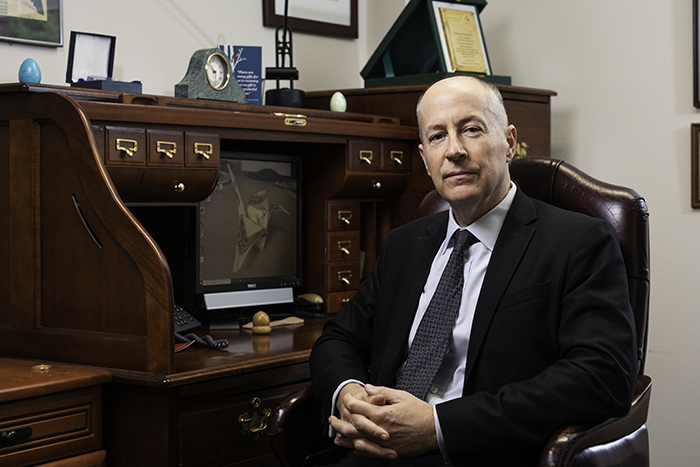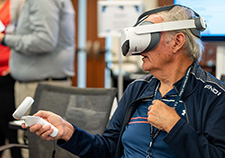Office of Research & Development |
 |


Dr. Keith Humphreys of VA Palo Alto chaired a commission that made seven categories of recommendations aimed at defusing the raging opioid crisis. (Photo by Adan Pulido)
February 3, 2022
By Mike Richman
VA Research Communications
"Our patients have suffered a great deal. We care for a Veteran population that's disproportionately male and disproportionately at that stage of life when pain is prevalent."
The U.S. Centers for Disease Control and Prevention recently announced that drug overdose deaths topped 100,000 for the first time in a one-year stretch. For the period of April 2020 to April 2021, CDC data showed a nearly 29% increase from the previous year.
Experts believe the precipitous rise was driven by abuse of the synthetic opioid fentanyl, as well as the COVID-19 pandemic, which has left many drug users feeling isolated and unable to get treatment or other support. Fentanyl is believed to be much more potent than heroin and morphine.
This unsettling news comes as addiction to opioids is already at epidemic levels. Opioids are a class of drugs that include pain relievers available by prescription. They also carry the risk of overdose and are often misused because of the euphoric feeling they induce. Addiction and overdoses occur among people using prescription opioids (natural and semi-synthetic opioids and methadone), street drugs such as heroin, and synthetic opioids such as fentanyl. All opioids have the ability to relieve pain and create a euphoric feeling.
The opioid crisis has especially permeated North America. Over the past quarter-century, it has cost the United States and Canada more than 600,000 lives, which exceeds their fatalities from World War I and II combined. Exacerbated by COVID-19, last year marked the worst year on record in both countries in opioid deaths. The United States saw a 33% spike in fatal overdoses from 2019 to nearly 70,000. In Canada, fatal opioid overdoses skyrocketed 62% from 2019 to more than 6,200.

VA opens new research center to seek novel arthritis treatments

Injectable gel could help treat degenerative back pain

Virtual reality technology helps Veterans in pain

Study outlines guidance for treating cancer patients who show a problematic pattern of opioid use
In response to the soaring opioid addictions and deaths in the United States and Canada over the past 25 years, Stanford University and the British journal The Lancet collaborated to form a commission. The commission combined Stanford scholars with other leading experts in the U.S. and Canada, with the goal of better understanding the opioid crisis and proposing solutions to stop its spread domestically and internationally.
In February 2022, the commission issued a paper highlighted by its findings on the opioid epidemic and made seven categories of recommendations aimed at defusing the crisis. The paper appeared in The Lancet.
Dr. Keith Humphreys, a professor of psychiatry in the Department of Psychiatry and Behavioral Sciences at Stanford University and a former White House drug policy advisor, chaired the commission. He’s also a career research scientist with the VA Palo Alto Health Care System in California.
Humphreys teaches addiction treatment methods to medical students, psychiatric residents, and clinical psychology interns. He has published more than 400 peer-reviewed scientific papers, receiving national and international awards for his work. In addition to the White House, he has been a consultant to the Centers for Disease Control and Prevention, the National Institute on Alcohol Abuse and Alcoholism, the Center for Mental Health Services, and other government agencies. He’s also deputy editor in chief of the journal Addiction.
Other VA researchers on the commission included Dr. Erin Krebs of the Minneapolis VA, Dr. Christine Timko of VA Palo Alto, and Dr. Amy Bohnert of the Ann Arbor VA in Michigan.
Humphreys spoke to VA Research Currents about the opioid epidemic, his commission’s recommendations, and what VA is doing to help Veterans addicted to opioids, among other pertinent issues.
VA Research Currents: Who is mostly to blame for the opioid crisis?
Humphreys: There’s plenty of blame to go around. The commission criticizes the manufacturers, companies like Purdue Pharma and Johnson & Johnson, for their aggressive and misleading marketing. Multiple manufacturers have been criminally convicted for lying about how dangerous these medications are. We also note failures in the FDA, which was too pliant when dealing with opioid manufacturers, including Purdue’s marketing campaign that suggested the opioid OxyContin was less addictive than other painkillers. That was a lie. There were also failures by distribution companies that over-shipped opioids. There were failures with the medical community being insufficiently critical and in some cases susceptible to bribery. We had doctors writing piles of prescriptions for money, not in VA, but in pill mills, which are facilities that resemble a regular pain clinic and that illegally prescribe opioids. There have also been failures in education in not giving medical, nursing, and dental students enough training about addiction. We don’t equip them for a condition they’re going to see every single day. There have been political failures, as well. A lot of money is sloshing around, and legislators and policymakers have sometimes been swayed by the wrong people. They listened to lobbyists when they should have listened to evidence. That was also a failure. We address that in the report, too.
How extensive is the opioid problem in VA given that chronic pain is such a huge problem with Veterans?
Our patients have suffered a great deal. There’s no other way to say it. We care for a Veteran population that’s disproportionately male and disproportionately at that stage of life when pain is prevalent. We have a lot of rural people, and a lot of people who face significant economic challenges. All of those things are risk factors for opioid addiction and overdose. We were not immune to the problems of over prescribing. I wish it weren’t true, but we definitely were part of the national surge of prescribing opioids too broadly. Last year, I collaborated with VA’s Dr. David Atkins, Dr. Carolyn Clancy, and Dr. William Becker on an article for the Journal of General Internal Medicine that documented how much Veterans have suffered from opioid addiction and how much we need to do for them.
What is VA doing to address the opioid crisis and addiction?
In the commission report, we cite the VA Opioid Safety Initiative as an example of a system getting itself organized and leading change to get back to more sensible prescribing. The commission recognizes the value of opioid prescribing but wants it done in an intelligent fashion. I think the Opioid Safety Initiative, VA’s Psychotropic Drug Safety Initiative, and the work that VA’s Pharmacy Benefits Management Services is doing are really good models for the rest of the health care system. They show how to get the health care system to lead this change, rather than what some systems did by sort of digging in their heels and making external forces force the change, with state legislators passing laws saying you can’t prescribe opioids. I’m proud that VA took the bull by the horns.
One of the things I like about VA is we do a number of things the entire health care system should do. The Opioid Safety Initiative is one example, and our treatment for addiction is another. If a Veteran comes to one of our addiction programs and has liver disease or needs psychiatric care or cancer care, they’re immediately connected in a medical setting, so they can get that care. That’s often not true in much of the American health care system. About half of addiction treatment programs in the United States don’t even have a physician on staff. Those programs can’t prescribe medications and can’t do any medical diagnoses and so on. Every VA addiction program has medical support.
What are the warning signs that someone is experiencing opioid use disorder?
With any of these substances, you look at things like to what extent this is impinging on other areas of a person’s life. Things that are important to most people like, “I’m causing harm to my family. I’m failing in my job or flunking out of school. I’m subjectively experiencing a lot of thought about opioids. I’m thinking more and more about how I’m going to get them today and when I’m going to take them next. I’m feeling urges to use painkillers and finding myself saying things like, Well, I’ll just take one,” and then take two, three, four, five. Another thing you see is tolerance to the physiological effects through repeated exposure. People need to take more opioids to get the same effect. In the absence of opioids, people start feeling bad and go into withdrawal, which causes flu-like symptoms and aches and pains. That tends to be part of the picture because the body is now used to opioids.
Of the commission’s seven categories of recommendations, does one stand out as being the most important?
One stands out for America. One stands out for the rest of the world. For America, it’s our recommendation to redesign health care to make the care of addiction a core component. That’s absolutely a huge thing to do. For the world, it’s not letting opioid companies do what the tobacco industry did. We tightened up on tobacco in America, but then the manufacturers said, “That’s okay, we’ll go to China and India and Africa,” and they did. They did a disgustingly effective job of creating addiction in other countries without regulations. The commission report documents that this is starting to happen with opioids, and we don’t want every other country to go through this horror.
These manufacturing companies are mostly based in the United States. We need to use the leverage we have over them to protect our friends around the world, not just ourselves. A lot of people outside the U.S. have a false sense that this could only happen in America. That’s just not true, as we document. First off, it’s already happened in Canada, and a number of other countries, as we show in the paper, have doubled and tripled in opioid prescribing. We know where that leads, and we want people to learn from our successes. We also want to learn from our mistakes. That’s important for the world.
Where do we go from here in terms of VA and the rest of the health care system implementing these recommendations and putting them to good use?
We have a comprehensive set of ideas about that. Some of them require legislation. For example, Medicaid insurance shuts off when you go into a correctional facility. So there’s nothing really to pay for your health care other than the system itself. That has made our overdose and addiction problem worse. because so many people don’t get treatments and lose their tolerance to the drug. Then they use the drug after release and die because they can’t stand their normal dose. One way to fix that is by reactivating Medicaid before they leave a correctional facility. A bill with bipartisan support in Congress called the Medicaid Reentry Act of 2021 aims to do that. It will say, “OK, you already have insurance. Your community provider will meet you at the door.” There’s a contract in place. These people are going to be paid by Medicaid. That way, you don’t have a situation where you only send them off and wish them good luck.
We’ve had a lot of good “insurance parity” laws put in place starting in 2008 and expanded in 2010 up to the present. They say if you get your insurance through work, which is how more than 100 million Americans get it, it has to cover mental health and addiction at the same level as any other health problem you might have. There have been challenges with companies not following that law, so the commission talks about the need for enforcement of the law. All of this is in the service of creating a system like VA already has, which is thinking about addiction care as a core part of health care. In the American system of health care, that means you have to think about the financing being a core part of it. That’s why we emphasize these approaches for mainstream health care reimbursement sources like Blue Cross, Blue Shields, and Aetna. Medicaid and Medicare also have to fully cover it. American medicine is driven by payers. Changing what insurers pay for is the way to get more care, but to also have care that’s integrated with the rest of the system.
Your paper notes that “the Commission is unequivocal in its view that addiction is an enduring feature of population health, though in the future the drug that takes center stage may not be opioids.” Please elaborate on that.
Throughout my whole life, there’s been some drug crisis or another on the front page. When I was young, there was the heroin crisis, followed by the cocaine crisis. Then we had a methamphetamine crisis, followed by an opioid crisis. And as always, people are dying from alcohol and tobacco. We tend to focus as a society politically on a particular drug, as if this is a unique and new problem. But it’s the same problem. It’s addiction. The particular type of addiction varies from era to era, but it’s never going to go away. We need to grapple with that.
The point we make in the paper is that addiction will never be gone. Maybe 10 years from now, the opioid crisis may not be the problem. But people will still be getting sick and dying from methamphetamines, alcohol, or tobacco. We're trying to get the country and all nations to accept that this problem is like a cancer. Unfortunately, there will always be people who get cancer. You can't get rid of cancer with a 24-month grant. You have to say, `Look, this is just part of taking care of people and one of society's enduring challenges.'
So basically some way, somehow there will always be some type of addiction.
Absolutely. In the modern world, we are so saturated with drugs. It’s beyond anything our evolution in history prepared us for. In the last 150 years, we’ve invented benzodiazepines, barbiturates, heroin, methamphetamines, amphetamines, and cocaine, and we have global commerce with the Internet. I wish it weren’t true. But it is. We’re always going to have addiction.
VA Research Currents archives || Sign up for VA Research updates